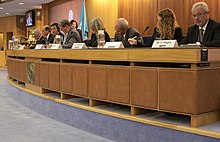Effects on international boundaries
During the 18th century, the British and the Dutch controlled opposite sides of the Straits of Malacca. The British and the Dutch drew a line separating the Straits into two halves. The agreement was that each party would be responsible for combating piracy in their respective half. Eventually this line became the border between Malaysia and Indonesia in the Straits.Law of nations

International Maritime Organization (IMO) conference on capacity-building to counter piracy in the Indian Ocean.
For a different opinion on Pirates as Hostis Humani Generis see Caninas, Osvaldo Peçanha. Modern Maritime Piracy: History, Present Situation and Challenges to International Law. Paper presented at the annual meeting of the ISA – ABRI JOINT INTERNATIONAL MEETING, Pontifical Catholic University, Rio de Janeiro Campus (PUC-Rio), Rio de Janeiro, Brazil, Jul 22, 2009
In the United States, criminal prosecution of piracy is authorized in the U.S. Constitution, Art. I Sec. 8 cl. 10:
The Congress shall have Power ... To define and punish Piracies and Felonies committed on the high Seas, and Offences against the Law of Nations;Title 18 U.S.C. § 1651 states:
Whoever, on the high seas, commits the crime of piracy as defined by the law of nations, and is afterwards brought into or found in the United States, shall be imprisoned for life.Citing the United States Supreme Court decision in the year 1820 case of United States v. Smith,[127] a U.S. District Court ruled in 2010 in the case of United States v. Said that the definition of piracy under section 1651 is confined to "robbery at sea." The piracy charges (but not other serious federal charges) against the defendants in the Said case were dismissed by the Court.[128]
Because of universal jurisdiction, action can be taken against pirates without objection from the flag state of the pirate vessel. This represents an exception to the principle extra territorium jus dicenti impune non paretur ("One who exercises jurisdiction out of his territory is not obeyed with impunity").[129]
International conventions
Articles 101 to 103 of UNCLOS
Articles 101 to 103 of the United Nations Convention on the Law of the Sea (UNCLOS) (1982) contain a definition of piracy iure gentium.[130] They read:This definition was formerly contained in articles 15 to 17 of the Convention on the High Seas signed at Geneva on 29 April 1958.[132] It was drafted[133] by the International Law Commission.[130]Article 101Definition of piracy
Piracy consists of any of the following acts:
- (a) any illegal acts of violence or detention, or any act of depredation, committed for private ends by the crew or the passengers of a private ship or a private aircraft, and directed—
- (i) on the high seas, against another ship or aircraft, or against persons or property on board such ship or aircraft;
- (ii) against a ship, aircraft, persons or property in a place outside the jurisdiction of any State;
- (b) any act of voluntary participation in the operation of a ship or of an aircraft with knowledge of facts making it a pirate ship or aircraft;
- (c) any act of inciting or of intentionally facilitating an act described in subparagraph (a) or (b).
Article 102Piracy by a warship, government ship or government aircraft whose crew has mutinied
The acts of piracy, as defined in article 101, committed by a warship, government ship or government aircraft whose crew has mutinied and taken control of the ship or aircraft are assimilated to acts committed by a private ship or aircraft.
Article 103Definition of a pirate ship or aircraft
A ship or aircraft is considered a pirate ship or aircraft if it is intended by the persons in dominant control to be used for the purpose of committing one of the acts referred to in article 101. The same applies if the ship or aircraft has been used to commit any such act, so long as it remains under the control of the persons guilty of that act.[131]
A limitation of article 101 above is that it confines piracy to the High Seas. As the majority of piratical acts occur within territorial waters, some pirates are able to go free as certain jurisdictions lack the resources to monitor their borders adequately.[citation needed]
IMB definition
The International Maritime Bureau (IMB) defines piracy as:- the act of boarding any vessel with an intent to commit theft or any other crime, and with an intent or capacity to use force in furtherance of that act.[134]
Uniformity in Maritime Piracy Law
Given the diverging definitions of piracy in international and municipal legal systems, some authors argue that greater uniformity in the law is required in order to strengthen anti-piracy legal instruments.[135]In popular culture
Main articles: List of fictional pirates and Pirates in popular culture

This image shows many of the characteristics commonly associated with a stereotypical pirate in popular culture, such as a parrot, pegleg, hook, cutlass, bicorne hat, Jolly Roger, Royal Navy jacket, bad teeth, maniacal grin, earrings, beard, and eyepatch.
The classic Gilbert and Sullivan operetta The Pirates of Penzance focuses on The Pirate King and his hopeless band of pirates on the South coast of England. The Pirate King is often believed to be inspiration for Jack Sparrow. The on-going manga One Piece details the adventures of Monkey D. Luffy and his crew to find the legendary treasure, The One Piece, and become the next King of the Pirates.
Many sports teams use "pirate" or a related term such as "raider" or "buccaneer" as their nickname, basing their gimmick around the popular stereotypes of pirates, as well as to give them an "intimidating" image. The Pittsburgh Pirates, a Major League Baseball team in Pittsburgh, Pennsylvania, are perhaps the most well-known, and actually got their nickname in 1891 after being accused of "piratical" actions by another team after they signed a player from the accusing team. The Oakland Raiders and Tampa Bay Buccaneers, both of whom play in the National Football League, also use pirate-related nicknames.


